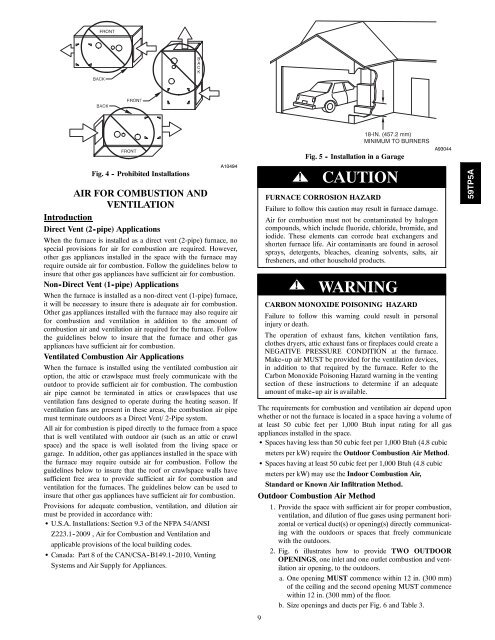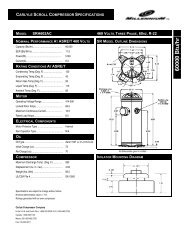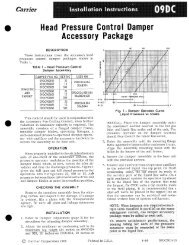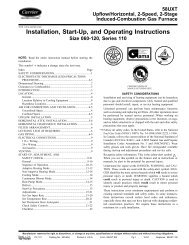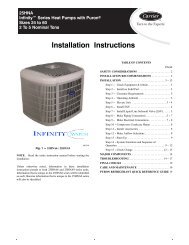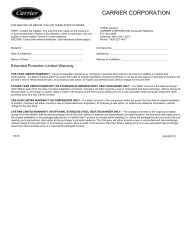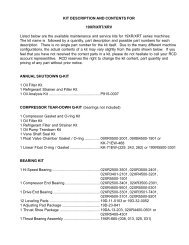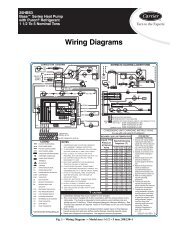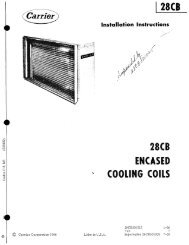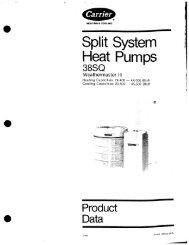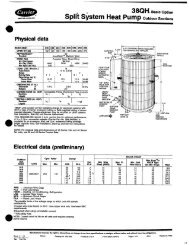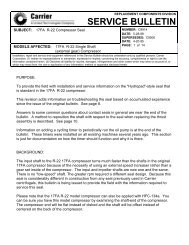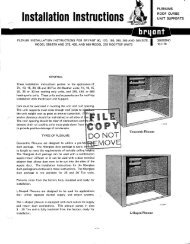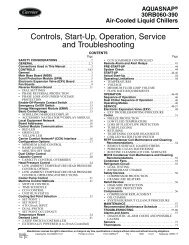warning - Docs.hvacpartners.com
warning - Docs.hvacpartners.com
warning - Docs.hvacpartners.com
You also want an ePaper? Increase the reach of your titles
YUMPU automatically turns print PDFs into web optimized ePapers that Google loves.
Fig. 4 - Prohibited InstallationsA10494AIR FOR COMBUSTION ANDVENTILATIONIntroductionDirect Vent (2-pipe) ApplicationsWhen the furnace is installed as a direct vent (2-pipe) furnace, nospecial provisions for air for <strong>com</strong>bustion are required. However,other gas appliances installed in the space with the furnace mayrequire outside air for <strong>com</strong>bustion. Follow the guidelines below toinsure that other gas appliances have sufficient air for <strong>com</strong>bustion.Non-Direct Vent (1-pipe) ApplicationsWhen the furnace is installed as a non-direct vent (1-pipe) furnace,it will be necessary to insure there is adequate air for <strong>com</strong>bustion.Other gas appliances installed with the furnace may also require airfor <strong>com</strong>bustion and ventilation in addition to the amount of<strong>com</strong>bustion air and ventilation air required for the furnace. Followthe guidelines below to insure that the furnace and other gasappliances have sufficient air for <strong>com</strong>bustion.Ventilated Combustion Air ApplicationsWhen the furnace is installed using the ventilated <strong>com</strong>bustion airoption, the attic or crawlspace must freely <strong>com</strong>municate with theoutdoor to provide sufficient air for <strong>com</strong>bustion. The <strong>com</strong>bustionair pipe cannot be terminated in attics or crawlspaces that useventilation fans designed to operate during the heating season. Ifventilation fans are present in these areas, the <strong>com</strong>bustion air pipemust terminate outdoors as a Direct Vent/ 2-Pipe system.All air for <strong>com</strong>bustion is piped directly to the furnace from a spacethat is well ventilated with outdoor air (such as an attic or crawlspace) and the space is well isolated from the living space orgarage. In addition, other gas appliances installed in the space withthe furnace may require outside air for <strong>com</strong>bustion. Follow theguidelines below to insure that the roof or crawlspace walls havesufficient free area to provide sufficient air for <strong>com</strong>bustion andventilation for the furnaces. The guidelines below can be used toinsure that other gas appliances have sufficient air for <strong>com</strong>bustion.Provisions for adequate <strong>com</strong>bustion, ventilation, and dilution airmust be provided in accordance with:S U.S.A. Installations: Section 9.3 of the NFPA 54/ANSIZ223.1 -2009 , Air for Combustion and Ventilation andapplicable provisions of the local building codes.S Canada: Part 8 of the CAN/CSA -B149.1 -2010, VentingSystems and Air Supply for Appliances.9!18-IN. (457.2 mm)MINIMUM TO BURNERSFig. 5 - Installation in a GarageCAUTIONFURNACE CORROSION HAZARDFailure to follow this caution may result in furnace damage.Air for <strong>com</strong>bustion must not be contaminated by halogen<strong>com</strong>pounds, which include fluoride, chloride, bromide, andiodide. These elements can corrode heat exchangers andshorten furnace life. Air contaminants are found in aerosolsprays, detergents, bleaches, cleaning solvents, salts, airfresheners, and other household products.! WARNINGCARBON MONOXIDE POISONING HAZARDFailure to follow this <strong>warning</strong> could result in personalinjury or death.The operation of exhaust fans, kitchen ventilation fans,clothes dryers, attic exhaust fans or fireplaces could create aNEGATIVE PRESSURE CONDITION at the furnace.Make -up air MUST be provided for the ventilation devices,in addition to that required by the furnace. Refer to theCarbon Monoxide Poisoning Hazard <strong>warning</strong> in the ventingsection of these instructions to determine if an adequateamount of make-up air is available.A93044The requirements for <strong>com</strong>bustion and ventilation air depend uponwhether or not the furnace is located in a space having a volume ofat least 50 cubic feet per 1,000 Btuh input rating for all gasappliances installed in the space.S Spaces having less than 50 cubic feet per 1,000 Btuh (4.8 cubicmeters per kW) require the Outdoor Combustion Air Method.S Spaces having at least 50 cubic feet per 1,000 Btuh (4.8 cubicmeters per kW) may use the Indoor Combustion Air,Standard or Known Air Infiltration Method.Outdoor Combustion Air Method1. Provide the space with sufficient air for proper <strong>com</strong>bustion,ventilation, and dilution of flue gases using permanent horizontalor vertical duct(s) or opening(s) directly <strong>com</strong>municatingwith the outdoors or spaces that freely <strong>com</strong>municatewith the outdoors.2. Fig. 6 illustrates how to provide TWO OUTDOOROPENINGS, one inlet and one outlet <strong>com</strong>bustion and ventilationair opening, to the outdoors.a. One opening MUST <strong>com</strong>mence within 12 in. (300 mm)of the ceiling and the second opening MUST <strong>com</strong>mencewithin 12 in. (300 mm) of the floor.b. Size openings and ducts per Fig. 6 and Table 3.59TP5A


